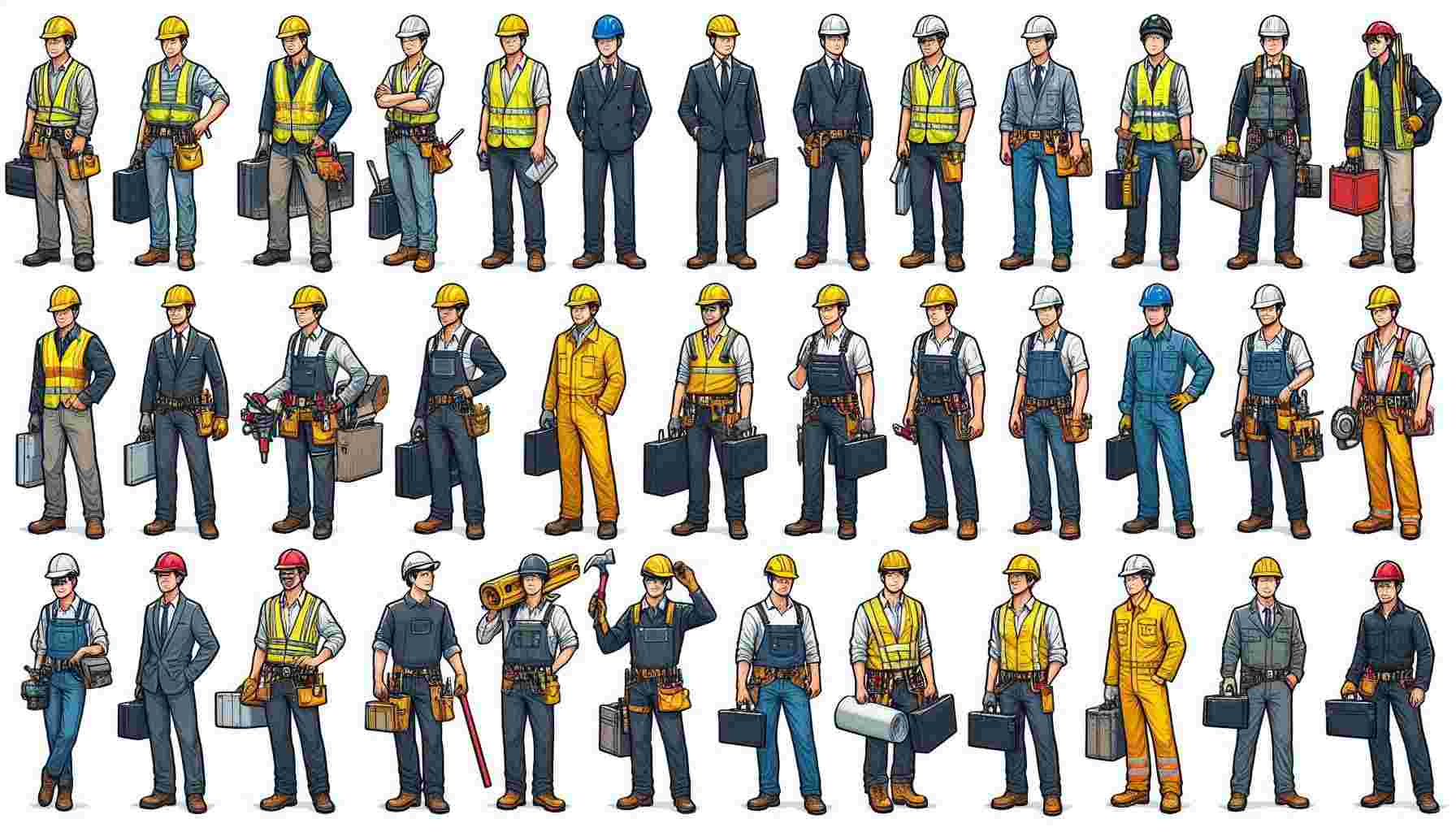Bustling construction site, filled with the sounds of heavy machinery and the buzz of activity. Amidst the controlled chaos, you’ll spot the unsung heroes of the building world – construction workers. But have you ever wondered what keeps these brave men and women safe as they tackle their demanding jobs? The answer lies in their outfit, a carefully curated ensemble of safety gear that’s as crucial as their skills and expertise.
Construction worker outfits aren’t just about looking the part; they’re a matter of life and death. Every piece of gear serves a specific purpose, protecting workers from the myriad of hazards they face daily. From falling debris to electrical shocks, the right equipment can mean the difference between a routine day on the job and a trip to the emergency room.
Key Takeaways:
- Construction worker outfits are essential for on-the-job safety
- Each piece of safety gear serves a specific protective function
- Proper use and maintenance of safety equipment is crucial
- Employers and workers share responsibility for safety compliance
- Regular training and updates on safety gear are necessary
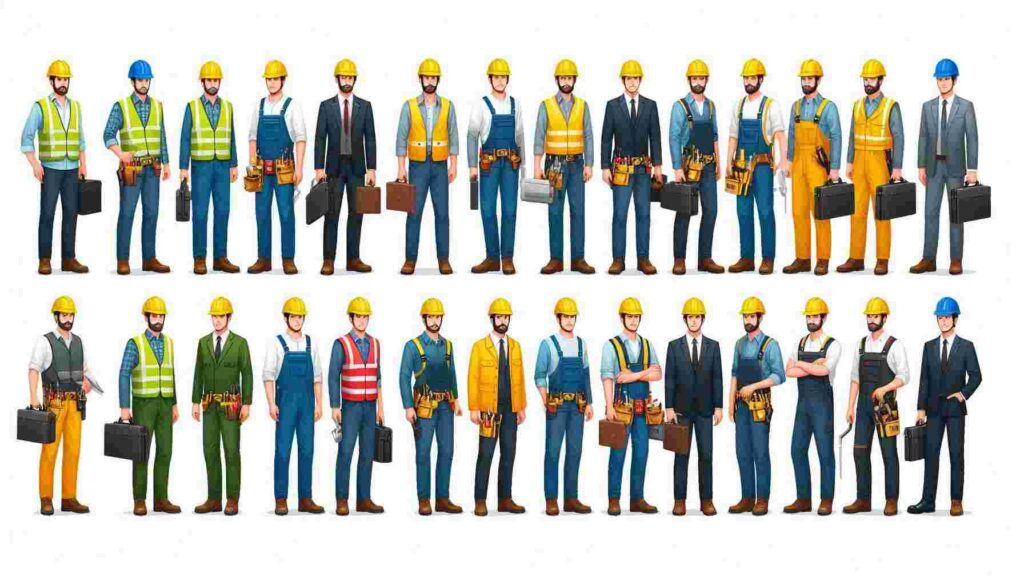
The Foundation of Safety: Hard Hats and Steel-Toed Boots
Let’s start from the top – literally. The iconic hard hat is the crown jewel of construction worker safety gear. These sturdy helmets aren’t just for show; they’re your first line of defense against falling objects, bumps, and electrical hazards. Made from high-density polyethylene or advanced thermoplastics, hard hats can absorb significant impact and deflect falling debris.
But here’s a pro tip: your hard hat is only as good as its fit. Make sure it’s snug but not tight, and always check for cracks or dents before each use. And don’t forget to replace it every 5 years or sooner if it’s taken a heavy hit!
Now, let’s talk about the other end of the spectrum – your feet. Steel-toed boots are the unsung heroes of construction sites. They protect your toes from heavy falling objects and provide stability on uneven surfaces. Look for boots with slip-resistant soles and electrical hazard protection for added safety.
When choosing boots, comfort is key. You’ll be on your feet all day, so opt for a pair that offers good arch support and cushioning. And don’t skimp on quality – your feet will thank you!
Visibility and Protection: High-Vis Clothing and Safety Glasses
Ever wonder why construction workers look like human traffic cones? It’s all about visibility, baby! High-visibility clothing, often in fluorescent yellow or orange, helps workers stand out in busy or low-light environments. This is especially crucial when working near moving vehicles or machinery.
When choosing high-vis gear, look for items that meet ANSI/ISEA standards. And remember, the brighter, the better! Some workers even opt for reflective strips on their hard hats for extra visibility.
Now, let’s focus on your peepers. Safety glasses are a must on any construction site. They protect your eyes from flying debris, dust, and harmful UV rays. For maximum protection, choose glasses with side shields and that meet ANSI Z87.1 standards.
And here’s a little secret: if you wear prescription glasses, you can get prescription safety glasses. No more awkward goggles over your regular specs!
Hearing Protection: Because Silence is Golden
Construction sites are loud – like, really loud. Prolonged exposure to high noise levels can lead to permanent hearing loss. That’s where earplugs and earmuffs come in handy.
Earplugs are great for continuous noise protection and can be disposable or reusable. Earmuffs, on the other hand, are better for intermittent loud noises and can be worn over earplugs for double protection.
When choosing hearing protection, look for the Noise Reduction Rating (NRR). The higher the NRR, the more protection it offers. And remember, the best hearing protection is the one you’ll actually wear consistently!
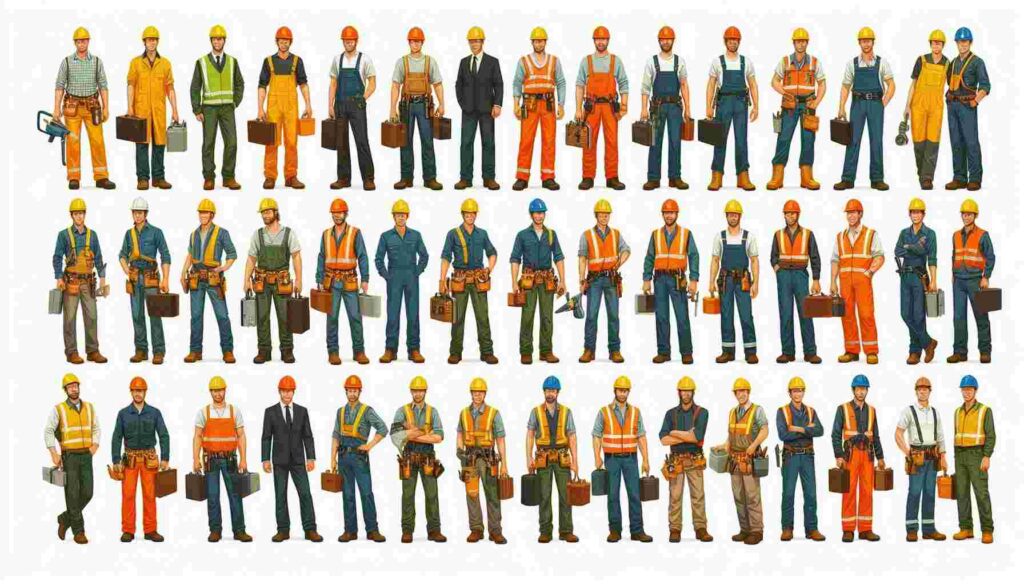
Respiratory Protection: Breathe Easy on the Job
Construction sites can be dusty, smoky, or filled with harmful fumes. That’s where respiratory protection comes in. Depending on the job and potential hazards, workers might need anything from a simple dust mask to a full-face respirator.
For general dust and particles, an N95 respirator is usually sufficient. But for more hazardous materials, you might need a half-face or full-face respirator with the appropriate filters.
Pro tip: Beards and respirators don’t mix well. For the best protection, keep that face smooth or opt for a loose-fitting powered air-purifying respirator (PAPR).
Hand and Body Protection: Gloves, Harnesses, and More
Your hands are your most important tools, so protect them! Different jobs require different types of gloves. For general construction work, leather gloves offer good protection against cuts and abrasions. For jobs involving chemicals, you’ll need specially rated chemical-resistant gloves.
When working at heights, a fall protection harness is non-negotiable. These harnesses distribute the force of a fall across your body, potentially saving your life. Make sure your harness fits properly and is inspected regularly for wear and tear.
And let’s not forget about your core. Depending on the job, you might need additional body protection like a safety vest, knee pads, or even a welding jacket. The key is to assess the risks of your specific task and gear up accordingly.
As we’ve seen, a construction worker’s outfit is much more than just clothes – it’s a carefully designed system of protection. But having the right gear is just the first step. Proper use, regular maintenance, and ongoing training are all crucial to ensuring these safety measures are effective. In the next section, we’ll dive deeper into how to choose the right gear for specific jobs and some advanced safety equipment that’s changing the game in construction safety…
Choosing the Right Gear for Specific Jobs
Alright, let’s get down to the nitty-gritty. Not all construction jobs are created equal, and neither is the safety gear you’ll need. For example, if you’re working with electrical systems, you’ll want to make sure your boots have that sweet, sweet electrical hazard protection. And if you’re dealing with hazardous materials? Well, my friend, you might need to upgrade to a chemical-resistant suit.
But here’s the thing – it’s not just about having the right gear, it’s about knowing how to use it properly. I once saw a guy wearing his safety harness like a fancy backpack. Spoiler alert: that’s not gonna save you if you take a tumble from the scaffolding!
Remember, your employer should provide training on how to use all this fancy equipment. If they haven’t, don’t be shy about asking. Your safety is worth more than feeling a bit awkward for a minute.
Advanced Safety Equipment: Welcome to the Future
Hold onto your hard hats, folks, because the world of construction safety is getting a high-tech makeover! We’re talking smart hard hats that can detect fatigue and alert workers to potential hazards. There’s even wearable exoskeletons that can help reduce strain and prevent injuries when lifting heavy objects.
But my personal favorite? Drones for site inspections. These little flying buddies can check out hard-to-reach or dangerous areas, keeping workers out of harm’s way. It’s like having your own personal safety scout!
Of course, all this fancy tech doesn’t replace good old-fashioned common sense and proper training. But it’s pretty cool to see how innovation is making construction sites safer every day.
The Role of Employers and Workers in Safety
Now, let’s talk responsibility. Employers have a legal and moral obligation to provide a safe working environment, including supplying appropriate safety gear. But workers, you’re not off the hook! It’s your job to actually use the equipment properly and consistently.
I’ve heard all the excuses: “It’s too hot,” “It’s uncomfortable,” “I’ll only be up there for a minute.” Trust me, those few seconds of discomfort are way better than a lifetime of injury. Plus, setting a good example can help create a culture of safety on the job site.
And hey, if you notice any issues with your safety gear or spot potential hazards, speak up! Your coworkers and your future self will thank you.
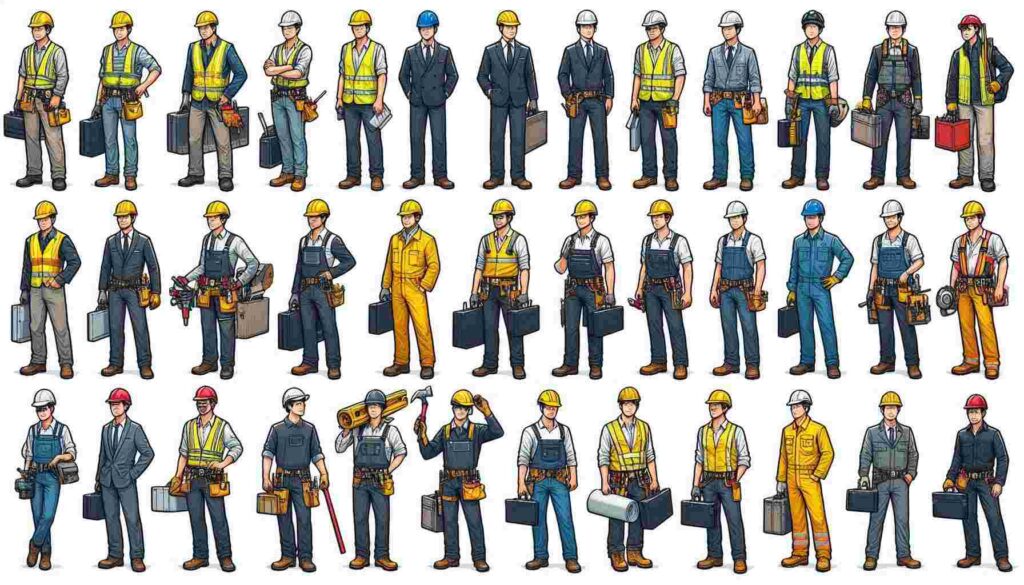
Maintaining Your Safety Gear
You wouldn’t drive a car that hasn’t been serviced in years, right? Well, the same goes for your safety gear. Regular inspections and maintenance are crucial to ensuring your equipment is up to snuff when you need it most.
Here’s a quick checklist to keep in mind:
- Check your hard hat for cracks or dents before each use
- Clean your safety glasses daily and replace them if they’re scratched
- Inspect your fall protection harness for fraying or damage before each use
- Replace earplugs regularly and keep earmuffs clean
- Store respirators in a clean, dry place and replace filters as recommended
Remember, your safety gear is only as good as its condition. Treat it right, and it’ll have your back when you need it most.
As we wrap up this deep dive into construction worker outfits, let’s take a moment to appreciate the thought and engineering that goes into keeping workers safe. From the iconic hard hat to the latest in wearable tech, every piece of gear plays a crucial role in ensuring workers can do their jobs safely and effectively.
So next time you pass a construction site, take a second to notice the workers’ outfits. They’re not just wearing a uniform – they’re suited up in a carefully designed system of protection that allows them to build our world while staying safe. And that, my friends, is pretty darn cool.
Remember, in the world of construction, fashion isn’t just about looking good – it’s about staying alive. So gear up, stay safe, and keep building the future!
Frequently Asked Questions
1. What are the essential items in a construction worker’s outfit?
The must-haves include a hard hat, steel-toed boots, high-visibility clothing, safety glasses, and work gloves. Depending on the job, you might also need hearing protection, respiratory gear, and fall protection harnesses.
2. How often should I replace my hard hat?
Generally, you should replace your hard hat every 5 years. However, if it’s been exposed to high heat, chemicals, or has taken a significant impact, replace it immediately. Always inspect your hard hat before each use for cracks or damage.
3. Are regular sunglasses okay to wear on a construction site?
Nope! Regular sunglasses don’t provide adequate protection from flying debris or impact. Always use safety glasses that meet ANSI Z87.1 standards. If you need prescription lenses, you can get prescription safety glasses.
4. What type of gloves should I wear for general construction work?
For general construction work, leather gloves are a good choice. They provide protection against cuts, abrasions, and minor heat exposure. However, for specific tasks like electrical work or handling chemicals, you’ll need specially rated gloves.
5. How do I know if my safety harness fits properly?
A properly fitting harness should be snug but not tight. You should be able to fit two fingers between the straps and your body. The D-ring should sit between your shoulder blades, and leg straps should be positioned under the buttocks. Always follow the manufacturer’s guidelines for proper fit and adjustment.
6. Can I wear my own clothes under my high-visibility vest?
Yes, but choose your underlayers wisely. Avoid wearing dark colors that might show through your high-vis gear. Opt for light-colored, breathable fabrics that won’t compromise the visibility of your safety clothing.
7. What’s the difference between earplugs and earmuffs?
Earplugs are inserted into the ear canal and are great for continuous noise protection. They’re small, comfortable for long periods, and can be disposable or reusable. Earmuffs, on the other hand, cover the entire ear and are better for intermittent loud noises. They’re easier to put on and take off but can be hot in warm weather.
8. How do I choose the right respiratory protection?
The type of respiratory protection you need depends on the specific hazards of your job. For general dust and particles, an N95 respirator is usually sufficient. For more hazardous materials or gases, you might need a half-face or full-face respirator with appropriate filters. Always consult with your safety supervisor to ensure you’re using the right protection for your tasks.
9. Can I wear my regular work boots instead of steel-toed boots?
No, regular work boots don’t provide adequate protection on a construction site. Steel-toed boots are designed to protect your feet from heavy falling objects and punctures. They also provide better traction and stability on uneven surfaces. Some sites may require boots with additional features like electrical hazard protection or metatarsal guards.
10. How do I care for my safety gear to ensure it lasts?
Proper care extends the life of your safety gear and ensures it functions correctly. Clean your hard hat with mild soap and water, avoiding harsh chemicals. Wash your high-vis clothing according to the manufacturer’s instructions to maintain its reflective properties. Store respirators in a clean, dry place away from sunlight and chemicals. Inspect all gear regularly for signs of wear and tear, and replace items as needed. Remember, well-maintained gear is effective gear!

